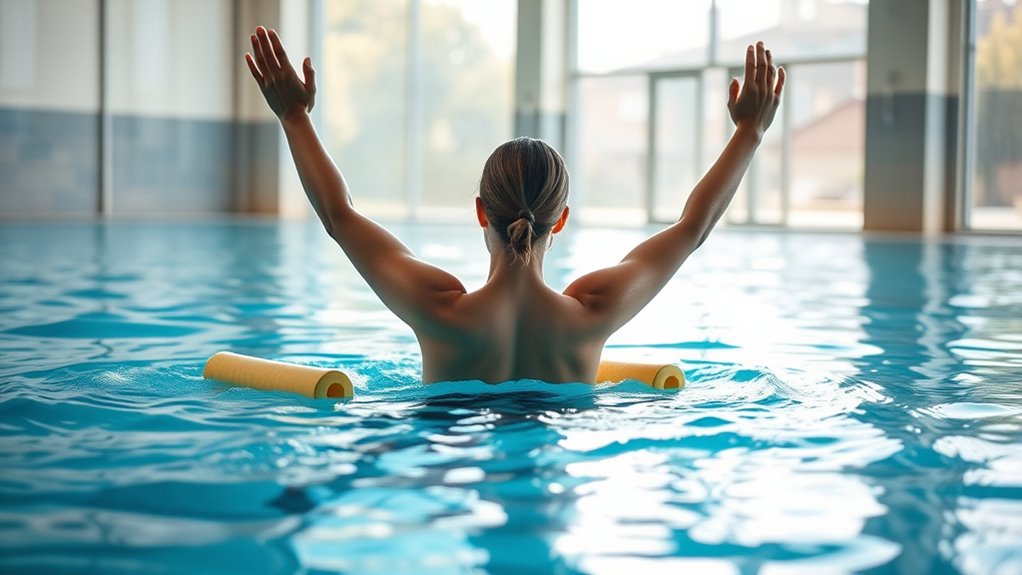To relieve back pain while strengthening your muscles without strain, try gentle water exercises that focus on slow, controlled movements. Activities like water marches, leg lifts, and torso twists in the pool help improve flexibility, support your spine, and reduce pressure on your muscles. The buoyancy minimizes impact, making movements easier and safer. Keep practicing regularly, and you’ll discover how aquatic exercises can gradually boost your mobility and ease back discomfort.
Key Takeaways
- Perform gentle water marches to activate core muscles without putting stress on your back.
- Use slow, controlled back extensions in water to strengthen back muscles safely.
- Incorporate side bends and torso twists to improve flexibility and reduce back tension.
- Focus on low-impact water aerobics that target core stability and spinal support.
- Gradually increase exercise duration and intensity, listening to your body to avoid strain.

Back pain can considerably impact your daily life, but performing exercises in the pool offers a gentle and effective way to find relief. When you choose aquatic stretching and water aerobics, you’re taking advantage of the water’s natural buoyancy, which reduces the stress on your spine and muscles. This makes it easier to move through gentle stretches and low-impact movements without risking further injury or discomfort. Aquatic stretching, in particular, allows you to lengthen tight muscles and improve flexibility, which can alleviate pressure on your back. By carefully stretching your hamstrings, hip flexors, and lower back muscles in the water, you help release tension and promote better posture. These movements are easy to modify depending on your comfort level, giving you control over your workout.
Water aerobics adds another dimension to your back pain relief routine. These classes typically involve a series of rhythmic, low-impact exercises that engage your core and back muscles without overloading them. The resistance of the water makes each movement more effective, helping you strengthen your back and abdominal muscles gently. As you perform water aerobics, you activate muscles that support your spine, which can lead to improved stability and reduced pain. Because the water cushions your joints, you’re less likely to experience strain or soreness afterward, making it a sustainable option for ongoing relief.
Water aerobics gently strengthens core and back muscles with low-impact resistance, supporting spine health and reducing pain.
Incorporating aquatic therapy techniques can further enhance your recovery process by targeting specific muscle groups and promoting healing through controlled movements. When you incorporate aquatic stretching and water aerobics into your routine, focus on controlled, smooth movements. Instead of rushing through exercises, take your time to feel the stretch and engage the correct muscles. For example, try gentle back extensions or side bends in chest-deep water, maintaining slow, deliberate motions. During water aerobics, emphasize exercises that target your core and back muscles, such as water marches, leg lifts, or gentle torso twists. These movements strengthen your muscles, improve flexibility, and promote better posture, all of which contribute to alleviating back pain.
Always listen to your body and avoid any exercise that causes sharp pain or discomfort. Starting slowly and gradually increasing intensity ensures your body adapts safely. The buoyant environment of the pool allows you to move more freely and with less fear of falling or overstressing your back. Consistency is key—regular sessions in the water can lead to significant improvements over time. By combining aquatic stretching with water aerobics, you create a balanced approach that strengthens your back muscles without putting undue strain on your spine, helping you find relief and regain your daily mobility.
Frequently Asked Questions
Can Pool Exercises Replace Physical Therapy for Back Pain?
You might wonder if water therapy can replace physical therapy for back pain. While pool exercises are excellent exercise alternatives, they shouldn’t fully replace professional guidance. Water therapy offers low-impact movement that helps strengthen your back without strain. However, consult your healthcare provider to ensure pool exercises complement your treatment plan. They can guide you on integrate water therapy safely with other therapies for maximum back pain relief.
Are Pool Exercises Suitable for Severe Back Injuries?
You might wonder if pool exercises suit severe back injuries. These exercises, with controlled water temperature and gentle exercise intensity, can be beneficial, but always consult your doctor first. Water’s buoyancy reduces strain, helping your back heal. However, for serious injuries, professional guidance is essential to avoid aggravating your condition. Never attempt unsupervised exercises if your injury is severe—safety comes first.
How Often Should I Do Pool Exercises for Back Pain Relief?
Think of your back as a delicate garden that needs regular tending. For relief, follow the frequency guidelines that recommend 3 to 4 times a week. Consistency is your best tool, helping your muscles grow stronger without overexertion. Don’t skip days, but also avoid overdoing it. By sticking to a steady routine, you’ll nurture your back’s health and gradually reduce pain, like watering a fragile plant to help it flourish.
Do Pool Exercises Help With Chronic or Acute Back Pain?
You might wonder if pool exercises help with chronic or acute back pain. Hydrotherapy benefits include reducing pain and inflammation, making aquatic therapy an effective treatment option. These exercises gently strengthen your back muscles without putting undue strain on your spine. By incorporating aquatic therapy into your routine, you can experience relief and improved mobility, whether your pain is ongoing or recent. It’s a safe, low-impact way to support recovery.
What Precautions Should I Take Before Starting Pool Exercises?
Before starting pool exercises, you should take some precautions. Check the water temperature, ensuring it’s warm enough to relax muscles but not too hot to cause discomfort. Also, consider the pool depth; start in shallow water to maintain stability and prevent falls. Always consult your healthcare provider if you have any health concerns, and listen to your body to avoid overexertion or injury during your exercises.
Conclusion
Incorporating pool exercises into your routine can effectively ease back pain and strengthen your muscles without putting extra strain on your spine. Many experts believe that water’s buoyancy reduces pressure, allowing you to move freely and safely. So, why not give these exercises a try? As long as you listen to your body and consult your healthcare provider, you’ll likely find relief and improved strength, making your pool sessions both enjoyable and beneficial.









